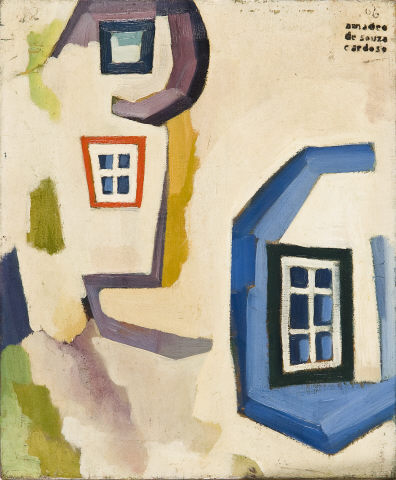
- 1915
- Canvas
- Oil
- Inv. 91P223
Amadeo de Souza-Cardoso
Janellas e postigos [Windows and Hatches]
With the news of the Great War onset, Amadeo retreated into the mountains of Manhufe in Portugal, to the family house whose inaccessibility blessed him with a chance for inexhaustible work. The following years would be lived in a spirit of creative partnership with his friends Robert and Sonia Delaunay, exiled nearby in Vila do Conde, and with Eduardo Viana, all of them thrilled by the vibrant multicolour of Portuguese folk art, creating pictures which time and again feature artisanal objects from the Minho region as their main subject, thereby revitalising the iconography and drab coloration of Cubism.
Between 1915 and 1916, Amadeo de Souza-Cardoso painted a series of isolated windows inspired in the local popular houses, in motives that are similar to the disks-targets of the Delaunay couple. This plastic recreation of the windows would be recurrent in his compositions during the following years, made of grids that are never symmetric and delimit fields of acid colours (blue, purple, yellow) with contrasting frames all around (black, orange, green). One can never see through Amadeo’s windows, for these have attained an abstract value of their own, as his painting was seeking ways to become more direct and immediate, giving up all illusions of three-dimensionality in order to affirm its own pictorial surface – an effect to which it was also decisive that he began using varnish in his oils, thus bringing out more vividly the glaze and contrast between the colour areas.
AR
March 2011
| Type | Value | Unit | Section |
| Height | 40,5 | cm | |
| Width | 33,2 | cm |
| Type | signed |
| Text | «amadeo / de souza / c ardoso» |
| Position | top right-hand corner |
| Type | Donation |
| Date | 01-07-1991 |
| Exposição de Pintura (Abstracionismo): amadeo de souza- cardoso/ Painting Exhibition (Abstractionism): amadeo de souza-cardoso |
| Porto, [s.n.], 1916 |
| Catalogue |
| Exposição de Pintura: amadeo de souza-cardoso/ Painting Exhibition: amadeo de souza-cardoso |
| Lisbon, [s.n.], 1916 |
| Catalogue |
| amadeo de souza-cardoso |
| Paris, Casa de Portugal, 1958 |
| Catalogue |
| Amadeo de Souza-Cardoso (1887-1918): Ein pionier aus Portugal/ Amadeo de Souza-Cardoso (1887-1918): A pioneer from Portugal |
| Hamburg, Ernst Barlach Haus, 2007 |
| Catalogue |
| amadeo de souza-cardoso |
| Paulo Ferreira |
| 23 January to 18 March 1958 Casa de Portugal |
| 19 May to 31 May 1956 Dominguez Alvarez Gallery |
| Exposição de Pintura: amadeo de souza-cardoso/ Painting Exhibition: amadeo de souza-cardoso |
| 4 December to 12 December 1916 Lisbon Naval League, Calhariz Palace |
| Exposição de Pintura (Abstracionismo): amadeo de souza- cardoso/ Painting Exhibition (Abstractionism): amadeo de souza-cardoso |
| 1 November to 12 November 1916 Ballroom of the Passos Manoel Garden |
| Centro de Arte Moderna José de Azeredo Perdigão/ José de Azeredo Perdigão Modern Art Centre (CAMJAP) |
| Amadeo de Souza-Cardoso (1887-1918): Ein pionier aus Portugal/ Amadeo de Souza-Cardoso (1887-1918): A pioneer from Portugal |
| 2 December 2007 to 30 March 2008 Ernst Barlach Haus |